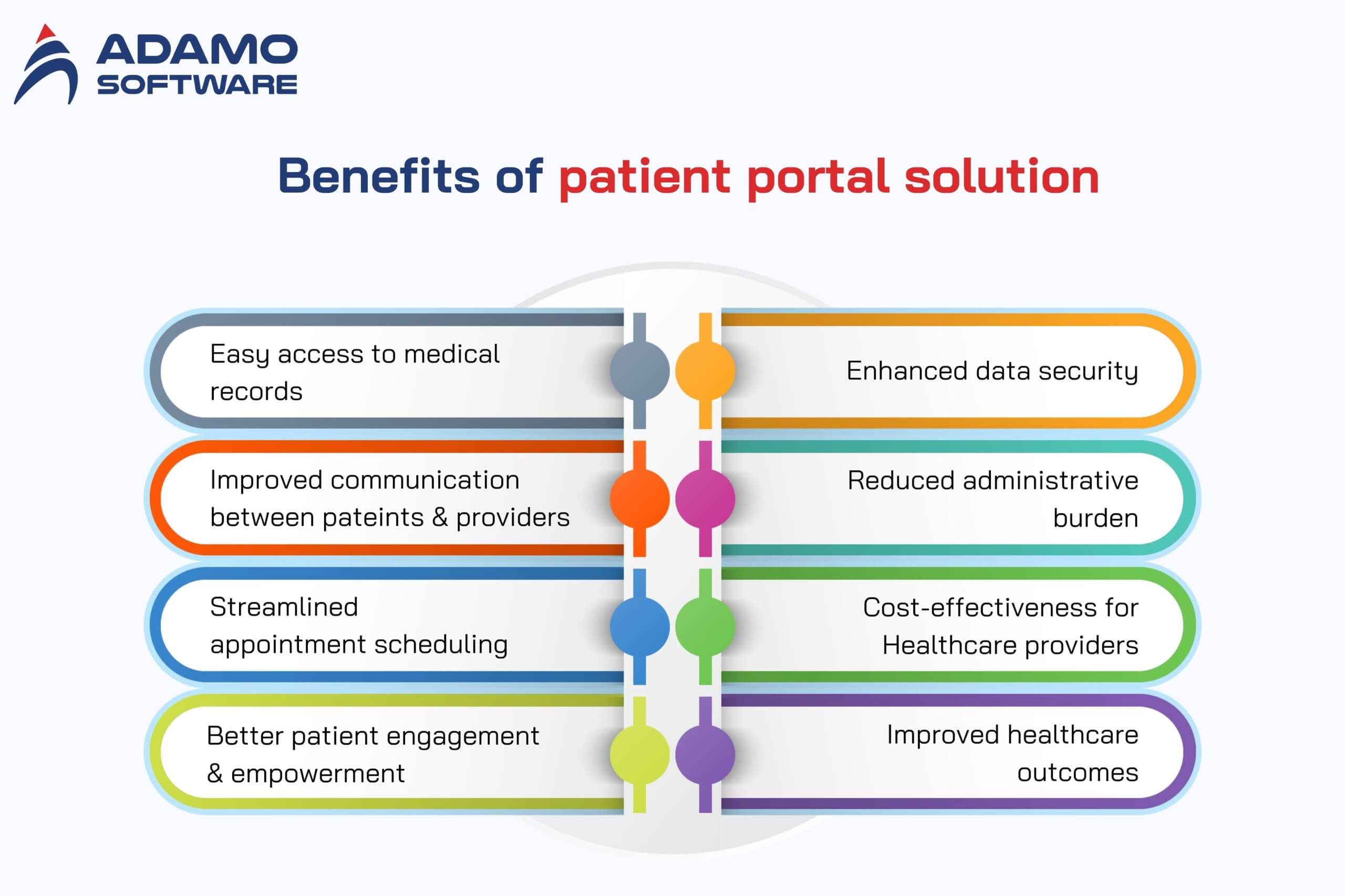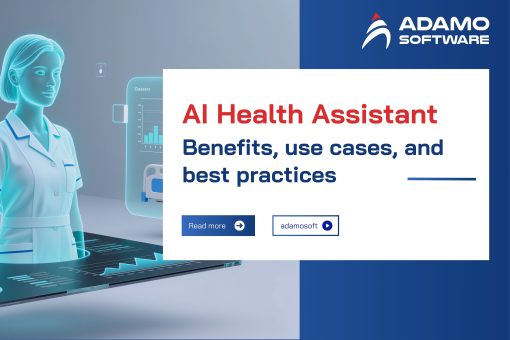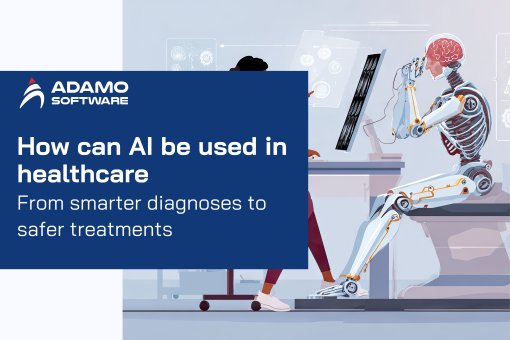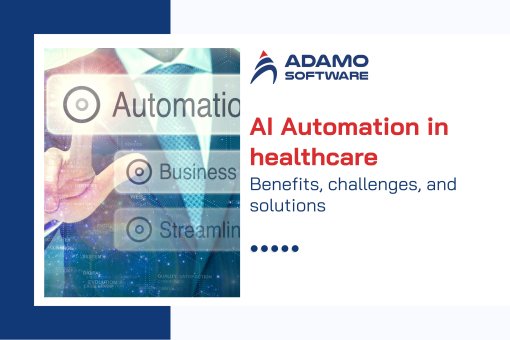Benefits of patient portal solution: Development cost included

M-Health and other advanced technology are redesigning the patient’s door to the use of their physicians. The patient portal solution is one of the most common and useful instruments. These portals are intended to grant patients full access to their electronic health records, appointments, and interactions with doctors. The need to improve functionality and transparency has led to the awareness of patient portal solutions that are hard to overemphasize.
However, like any other system, there are several benefits of patient portal solution. At the same time, they present some challenges to face. However, such a system calls for planning. It is important to establish some of the costs to be incurred. In this article, you will read about the benefits of patient portal solution, its cons, and the price for development. We will also explain how this can be of particular importance to working with a reliable development company, like Adamo Software.
I. Benefits of patient portal solution
The healthcare sector requires frequent changes, and the use of digital technologies is one of the important factors affecting positive change for patients. Customer web portals have become a core offering in contemporary society, where patient portal solutions are paramount. They offer patients meaningful ways of accessing information about their health and afford easy interoperability with providers. To fully comprehend how patient portal solutions can improve patients’ and healthcare organizations’ performance, it is crucial to understand the purpose of such patient engagement software.

1. Easy Access to Medical Records
Hong and Au’s study reveals that a patient portal solution has several advantages. For example, by using a patient portal people can access their results of tests, medical history, immunization records, medications, and treatments from any location. This access has been said to enable patients to know their health status and record their experience during the disease.
Further, it allows the preparation of every patient for subsequent consultations or treatments through a synthesis of previous consultations or treatment plans. He also failed to limit the communication of such information. Hence when patients want to know whether their details are ready or not, they will not have to call the office implying convenience and time saving.
Ready to Outsource?
Discover how we can transform your business with expert IT solutions.
2. Improved Communication Between Patients and Providers
But now, let us focus on the benefits of patient portal solutions. One of the key areas includes the provision of improved communication both for the patient and the provider. Thanks to secure messaging, for example, the patient can communicate with his or her doctor or other medical staff that are involved when he or she has some questions or concerns and makes some requests. This field allows the user to submit requests for clarification of the diagnosis or to schedule a meeting without phone calls and personal meetings, all through the safety of the portal. It also minimizes delays since healthcare providers receive and respond to patients’ needs without delay.
Additionally, a patient’s portal can be used as a communication tool in bidirectional; therefore, doctors may reach out to their patients with follow-up instructions and other essential information such as lab results and treatment updates, making the overall care experience remarkable.
3. Streamlined Appointment Scheduling
As a result, below are the benefits of patient portal solution; Easy scheduling for appointments. Conventionally, the patients had to make phone calls to the healthcare offices for appointment bookings, and this will subsite results to demoralizing. Using a patient portal, the patient can go to the portal in their own free time, see the available time for appointments, and book appointments without having to consult with the medical office.
It also minimizes inconveniences resulting from uncounseled patients or failed appointments because of reminders or flexible appointment settings. This feature is advantageous to healthcare providers also for the reason that it lessens the volume of administrative burden and directs the attention of the staff on higher recognition tasks consequently enhancing circulation in clinics.
4. Better Patient Engagement and Empowerment
A few benefits of patient portal solution include increased engagement and activation of patients about their health. Through the portal, the patient can manage different symptoms and take reminders for medication intake. Patients can also look after chronic diseases and participate in programs for preventing diseases. Such enhanced engagement means that patient outcomes are improved. Individuals are taking a broader role in managing their health. Using patient portals also promotes some level of openness in how patient care is delivered.
Thus, it improves patient-provider interaction. Patient portals allow patients to learn about available educational materials, get health tips, and receive personal health information.
5. Enhanced Data Security
Privacy of health information is an issue of concern when working with patients’ data. One of the benefits of patient portal solutions is that they are communication solutions that ensure that health data is secure. Technological techniques such as high-level encryption are applied when developing patient portals of health information. Therefore, the information exchanged is only limited to the patient, their healthcare provider, and the third party if any. Patient portals are much more secure than email or conversations on paper since they can be easily breached.
Besides, this increases security and helps to ensure patient confidentiality and compliance with the requirements of the USA healthcare legislation such as HIPAA.
6. Reduced Administrative Burden
The benefits of patient portal solution are also not felt on the part of the healthcare provider since administrative costs are also less. Online payment of bills, appointments, and records updates of patients’ cases are among some features that make work in patient portals easier. Hence it reduces the time and resources used for administrative work. Doctors, nurses, and other healthcare professionals do not have to schedule appointments or receive countless repeat phone calls. It helps them keep their eye on more important things such as offering care to the patients.
Also, the performance of repetitive tasks decreases the likelihood of error by people. Besides, it increases the overall organizational effectiveness and patient experience.
7. Cost-Effectiveness for Healthcare Providers
Patient portal solution also has some impacts on healthcare organizations in terms of costs. Patient portals decrease administrative burdens through proper recording of medical records, facilitating communication between care providers and patients, and reducing paperwork. It is poised to reduce operational expenses among healthcare providers.
For instance, there are fewer phone calls and less administrative staff time needed to complete the patient’s requests. Such a way of scheduling appointments can also lower the necessity of having many front-office employees. The immense cost savings that can be realized over time put a check to the financial drain in a healthcare organization while enhancing the quality-of-service delivery to patients.
8. Improved Healthcare Outcomes
Due to enabling patients to take more control over their health, patient portals lead to the enhancement of healthcare results. There are several reasons why patients’ records should be accessible to the patients include. First, this will ensure compliance with treatment regimens and follow-up on the recommended tests. Second, patients will always remember to take their medication at appropriate times. The portal can also be used by healthcare providers to track the progress of the patients. It provides cues for check-ups and modifies treatment plans. It can reduce readmission rates to hospitals, offer better chronic conditions control, and improve patient health, and overall experience.
Conclusively, the patient portal solution is more than a digital way of managing records of patients and treatment by Byron and Baldewing [ACHP]. These include removing communication barriers, addressing consumer engagement, increasing safety, and minimizing paperwork. Therefore, it improves health outcomes. Through the patient portal technology, caregivers can design a care delivery model that is more effective, patient-friendly, and nonprofit.
Ready to Outsource?
Get top-tier IT talent without the hassle. Contact us now!
II. Drawbacks of patient portal apps
However, to offer patients a better portal solution some challenges need to be emphasized. In this part of the paper, the negative implications of these solutions and how they affect the quality of health care will be discussed. These organizations need to comprehend these unfavorable outcome factors. Hence, they can determine if a patient portal solution might benefit their practice.

1. Technical Issues and Accessibility Challenges
The technical issue is one of the typical problems of patient portal apps. These apps may develop minor matters such as frequent crashing, lagging, or freezing. At worst, the patient app may occasionally crash, which would make it impossible for patients to retrieve their health information during emergencies. Furthermore, the larger group of patients may not be familiar with technologies or the internet to contribute to the benefits of the patient portal solution. This causes frustration and lack of accessibility to information.
2. Privacy and Security Concerns
Patient portals improve the aspect of security or data privacy because there is always a worry regarding security and data breaches. The patient portal solution’s advantages are indeed represented by the fact that patients have secured encrypted access to their records. Meanwhile, it would turn into a disadvantage if the system were not well maintained or protected. Since it will lead to the leakage of patients’ important information to bad gets. As healthcare data has now become an attractive target for cyber threats, effective security measures need to be in place. If the patients feel their privacy is at risk, they may not respond to the portal or use it only limitedly. Thus, this makes the portal completely useless.
3. Limited Functionality for Some Patients
This is pegged down to the fact that mHealth has limited functionality for some patients. Secondly, patient portal apps may not contain the full set of functions that some patients require. For instance, not all forms of patient portal solutions will enable a patient to monitor all the features of their health. They can be fitness or nutritional values. This might not be very beneficial for a patient with a chronic disease.
Besides, if the interface of the portal is not friendly or if they receive inadequate information when they are in the portal, some patients may not find their way around this portal and may not be able to benefit from the functionality it offers. This can lead to frustration and subsequently reduced utilization of the portal thus the improvement of patient care will also be inhibited.
4. Resistance from Healthcare Providers and Staff
Despite the numerous advantages that come with the implementation of a patient portal solution, there are various healthcare providers and their staff who will be resistant to the implementation of the systems. The change from paper-based operations to platform systems can become a burden mainly for small practices with few finances or technical experience.
While a patient portal system is a wonderful tool, its use does entail other factors that the organization means shelling out additional time, training, and recruitment of staff and investment. This needs to be managed. When the staff is not committed to the technology there could be organizational problems and low patient utilization.
5. Risk of Overloading Patients with Information
One of the issues recognized about patient portals is that the flow of information can be overwhelming at times. Key benefits of patient portal solution are retrieving the medical records, test results, and treatment plans. However, information accessibility has a flip side when there are loads of it in a single place. It becomes confusing or creates worry out of the blues. For instance, through lack of familiarity with interpreting medical records, or test results, the patient can get distressed or become even more reluctant to use the portal. This problem should be avoided by providing patients with clear, concise, and easily understood information from their healthcare providers.
In conclusion, these potential challenges of patient and provider portals have to be well assessed in the healthcare organizations to meet patient and provider expectations and not to create new major hurdles. There are some drawbacks in the following ways. Healthcare providers should be aware of them to shape a better and more efficient working model of patient portals.
III. How much does patient portal software development cost?
It is important when selecting a patient portal that one appreciates the costs of developing the solution. There are however other costs which may include. Nevertheless, when it comes to patient portal solutions, the opportunities seem obvious. On the other hand, the investment should be considered. Here, the author provides information on some factors that define the cost of patient portal development.
1. Features and Complexity
The components of the portal have a direct relation to the development costs. However, some basic portals will cost less to develop, but adding special features like video consults or panel results based on AI data will raise the cost further. That is, the higher the degree of sophistication of the underlying technology the higher the cost will be. The full appropriation of the patient portal solution may also mean more resource input into these enhanced functions.
2. Customization and Design
Customization and design also determine costs. There is also a need to spend more time and resources to achieve the right perception suitable for your business, thereby incurring higher costs. The use of templates can be cheaper. However, be aware of its restrictions regarding patient portal solutions. When design is personalized it enhances usability.
3. Development Team and Location
The cost depends on the location of the development team you hire. Teams based in North America and Western Europe will be higher than those of teams in Eastern Europe or Asia. But that may interrupt communication and time differences. There is always a trade-off between cost, quality, and expertise when choosing a team to help realize the advantages of patient portal solutions.
4. Maintenance and Updates
The portal will need constant updates and maintenance to remain secure and running for the audience’s benefit. Frequency to update the system, and to check for any lapses that the new system must correct to enforce full compliance should also be considered in the cost aspect. This guarantees the HOS PAC and the benefits of patient portal solution to go on in the long run.
5. Integration with Other Systems
Connecting it with the other integrated systems in healthcare such as the EHR or billing software can be costly in the development aspect. However, better integration can bring more benefits to the patient portal solution where different processes can be simplified and bring much more accuracy.
6. Size of the Healthcare Organization
Large organizations may require enhanced and elaborate portals which may enhance the overall development cost. For the necessity of the new patient portal solution, smaller practices may need an easier patient portal with a more reasonable price.
It is possible to conclude with high certainty that the cost of a patient portal solution will not be the same across all projects because the activities depend on several factors. Even though development costs may increase, the patient portal solution is usually offset by better handling of patients and administrative work.
IV. Consider Adamo Software as your trusted partner for Health Patient Portal App development

So, special emphasis should be placed on selecting a proper and experienced provider to develop a patient portal solution. At Adamo Software, professionals can help healthcare organizations develop patient portals that are secure, easy to use, and can accommodate the needs of healthcare organizations at the present and in the future. Their team knows the significance of making patient portal solutions deliver value to its patient and provider interface in its simplest and most efficient manner. Whether it is designing a new online portal from scratch, or integrating existing structures of your healthcare organization, Adamo Software can assist in building an outstanding Web 2.0 portal that generates increased interest, streamlined organization, and improved satisfaction.
Adamo Software is here to provide you with a dedicated development team, who understand deeply about healthcare software solutions. We will help you implement them successfully with no issues. Whether a client wants to implement higher-level functions, such as telemedicine compatibility, or an intuitive design, Adamo Software is your go-to solution to build a patient portal that fosters better care delivery and operation.
FAQs
1. What are the main benefits of patient portal solutions?
The patient portal solution has the benefits of enhanced patient involvement, enhanced health record accessibility, and enhanced patient-provider interactions. These portals facilitate the arranging of appointments, performing self-tests of received results, doctor-patient consultations, and many other things securely and conveniently. Thus, it enhances overall healthcare encounters and their productivity.
2. Are patient portal solutions secure?
Indeed, patient portal solutions are developed with security as an important key aspect. They normally employ quality and effective data encryption and secure feature authentication for patients’ records. Patient’s touchy data is protected, and both the people, patients, and providers, can confide in these means with their close-to-heart health details.
3. Can patient portals be customized for different healthcare practices?
Absolutely! Thus, one of the advantages noted with patient portal solutions is increased flexibility. Portals can be designed corresponding to the requirements of a single doctor, several practices, or a hospital. This ensures that most of the features and functionalities provided meet the needs of the various organizational processes in the organization.
4. How do patient portals improve communication between patients and healthcare providers?
This improves communication by doing it in a faster and more efficient manner. They can easily get in touch with their doctors using text messages if they have questions or need a refill. This makes the work efficient for patients and the healthcare teams; while enhancing the experience of a patient through the patient portal solution.
5. How much does it cost to develop a patient portal?
The expense of designation and construction of a patient portal relies on the likes of the qualities incorporated and exactly how trendy the distinguished patient portal is. Simple portals might be cheap, while getting a complex system with features, such as telemedicine integration, may be expensive. However, the benefits of patient portal solution usually pay for the cost of implementation by bringing improvement to patient experience and hospital workflow.











